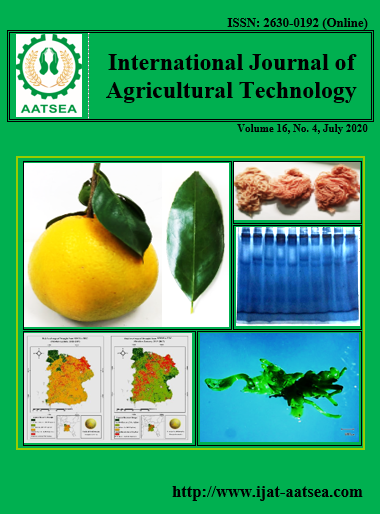Transformation RNA interference-mediated silencing of the Flavanone 3-Hydroxylase gene in Lotus (Nelumbo nucifera Geartn. cv. Buntharik)
Main Article Content
Abstract
RNA interference mediated-silencing of the F3H gene in the lotus (Nelumbo nucifera Geartn.) cv. Buntharik inhibited the anthocyanin pathway after gene transformation. The plasmid pJA8F3H contained the inverted repeats of F3H fragments, bar gene as a selectable marker in plants, which is resistant to basta (glufosinate amonium). The transformation of particle bombardment was obtained with multiple shoots of lotus. F3H gene expression analysis showed that expression of F3H decreased in transgenic lotus when compared with the control. On the first and the second test, 5 transgenic lotus of the relative expression F3H gene was detected with 0.0496 and 0.466 times, respectively. The inhibition of gene expression decreased when they were cultured for a long time. The expression F3H gene was detected by RT-PCR, and real-time PCR resulted in consistent decreasing in the transgenic lotus compared with the non-transgenic lotus, which was able to inhibit the expression F3H gene.
Article Details

This work is licensed under a Creative Commons Attribution-NonCommercial-NoDerivatives 4.0 International License.
References
Aida, R., Kishimoto, S., Tanaka, Y. and Shibata, M. (2000). Modification of flower colour in toronia (Torenia fournieri Lind.) by genetic transformation. Plant Science, 153:33-42.
Buathong, R., Saetiew, K., Phansirib, S., Parinthawong, N. and Arunyanart, S. (2013). Tissue culture and transformation of the antisense DFR gene into lotus (Nelumbo nucifera Gaertn.) through particle bombardment. Scientia Horticulturae, 161:216-222.
Chaipanya, C., Saetiew, K., Arunyanart, S. and Parinthawong, N. (2017). Isolation and expression analysis of the Flavanone 3-Hydroxylase genes in lotus (Nelumbo nucifera Gaertn.), waterlily (Nymphaea sp.) and transient silencing in waterlily. Chiang Mai Journal of Science, 44:427-437.
Livak, J. k. and Schmittgen, T. D. (2001). Analysis of relative gene expression data using real-time quantitative PCR and the 2-ΔΔCp method. Elsevier Science, 25:402-408.
Li, F., Jin, Z., Qu, W., Zhao, D. and Ma, F. (2006). Cloneing of a cDNA encoding the Saussurea medusa chalcone isomerase and its expression in transgenic tobacco. Plant Physiology and Biochemistry, 44:455-461.
Nakatsuka, T., Abe, Y., Kakizaki, Y., Yamamura, S. and Nishihara, M. (2007). Production of red flowered plants by genetic engineering of multiple flavonoid biosynthetic genes. Plant Cell Report, 26:1951-1959.
Nakasuka, T., Mishibaa, K., Abe, Y., Kubota, A., Kakizaki, Y., Yamamura, S. and Nishihara, M. (2008). Flower color modification of gentian plants by RNAi-mediated gene silencing. Plant Biotechnology, 25:61-68.
Nishihara, M., Nakatsuka, T., Hosokawa, K., Yokoi, T., Abe, Y., Mishiba, K. and Yamamura, S. (2006). Dominant inheritance of white-flowered and herbicide-resistant traits in transgenic gentian plants. Plant Biotechnology, 23:25-31.
One, E., Fukuchi-Mizutani, M., Nakamura, N., Fukui, Y., Yonekura-Sakakibara, K., Yamaguchi, M., Nakayama, T., Tanaka, T., Kusumi, T. and Tanaka, Y. (2006). Yellow flowers generated by expression of the aurone biosynthetic pathway. Plant Biology, 103:11075-11080.
Saetiew, K., Leerhaweesup, W., Parinthawong, N. and Arunyanart, S. (2014). Transformation of antisense Dihydroflavonal 4-reductase (DFR) into sacred lotus ‘Buntharik’ using Agrobacterium-mediated gene transfer. Acta Horticulturae, 1025:99-106.
Takashi, N., Mishibaa, K., Abe, Y., Kubota, A., Kakizaki, Y., Yamamura, S. and Nishihara, M. (2008). Flower color modification of gentian plants by RNAi-mediated gene silencing. Plant Biotechnology, 25:61-68.
Tsuda, S., Fukui, Y., Nakamura, N., Katsumoto, Y., Ohira, K., Ueyama, Y., Ohkawa, H., Holton, T. A., Kusumi T. and Tanaka, Y. (2004). Flower color modification of Petunia hybrida commercial varieties by metabolic engineering. Plant Biotechnology, 21:377-386.
Waterhouse P. M., Graham, M. W. and Wang, M. B. (1998). Virus resistance and gene silencing in plant can be induced by simultaneous expression of sense and antisense RNA. Proceedings of National Academy of Sciences of the United States of America, 95:13957-13964.
Yong, W., Abdullah, J. O. and Mahmood, M. (2009). Agrobacterium-mediated transformation of Melastoma malabathricum and Tibouchina semidicandra with sense and antisense dihydroflavonol 4-reductase (DFR) genes. Plant Cell, Tissue and Organ Culture, 96:59-67.
Zuker, A., Tzfira, T., Ben-Meir, H., Ovadis, M., Shklarman, E., Itzhaki, H., Forkman, G., Martens, S., Neta-Sharir, I., Weiss, D. and Vainstein, A. (2002). Modification of flower color and fragrance by antisense suppression of flavonone 3-hydroxylase gene. Mol Breeding, 9:33-41.


